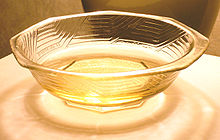Mirin

Mirin (味醂 or みりん, Japanese: [miɾiɴ]) is a type of rice wine and a common ingredient in Japanese cooking. It is similar to sake but with a lower alcohol content and higher sugar content.[1] The sugar content is a complex carbohydrate that forms naturally during the fermentation process; no sugars are added. The alcohol content is further lowered when the liquid is heated.
Types[edit]
Three types of products are marketed as mirin. The first is hon mirin (literally: true mirin),[2] which contains about 14% alcohol and is produced by a 40 to 60 day mashing (saccharification) process.[3] The second is shio mirin (literally: salt mirin), which contains a minimum of 1.5% salt to prevent consumption in order to avoid alcohol tax.[4]
The third are mirin-like seasonings called shin mirin (literally: new mirin),[5] or mirin-fu chomiryo (literally: mirin-like seasoning),[6] which are substitutes not actually mirin.[7] They are blends of sweetener syrups, flavorings such as kōji extracts, and flavour enhancers.[3] They contain less than 1% alcohol.[3]
The term or trade name aji-mirin (literally: taste mirin) can mean various things, such as salt mirin,[8] synthetic mirin,[6] or mirin-like seasonings.[7]
Uses[edit]
In the Edo period, mirin was consumed as amazake.[9] O-toso, traditionally consumed for the Japanese New Year, can be made by soaking a spice mixture in mirin.[10]
In the Kansai style of cooking, mirin is briefly boiled before use, allowing some alcohol to evaporate. In the Kantō regional style, the mirin is used untreated. Kansai-style boiled mirin is called nikiri mirin (煮切り味醂)[11] (literally: thoroughly boiled mirin).

Mirin adds a bright touch to grilled or broiled fish or erases the fishy smell. A small amount is often used instead of sugar and soy sauce. It is sometimes used to accompany sushi.
Mirin is also an ingredient in other sauces:
- Kabayaki (grilled eel) sauce: mirin, soy sauce, sake, sugar, fish bone (optional)[12]
- Nikiri mirin sauce: soy sauce, dashi, mirin, sake, in a ratio of 10:2:1:1
- Sushi su (sushi rice vinaigrette): rice wine vinegar, sugar, nikiri mirin sauce
- Teriyaki sauce[6]
See also[edit]
- Japanese flavorings
- Mijiu – Chinese rice wine that can be used in cooking
- Huangjiu – Chinese rice wine that can be used in cooking
References[edit]
- ^ Shimbo, Hiroko; Shimbo Beitchman (2000). The Japanese Kitchen: 250 Recipes in a Traditional Spirit. Ming Tsai. Harvard Common Press. p. 75. ISBN 978-1-55832-177-9.
- ^ Yamaguchi, Roy; Joan Namkoong; Maren Caruso (2003). Hawaii Cooks: Flavors from Roy's Pacific Rim Kitchen. Ten Speed Press. p. 19. ISBN 978-1-58008-454-3.
- ^ a b c 本みりんの知識 [About hon-mirin] (in Japanese). 全国味淋協会 (literally:Japan Mirin Association). Retrieved 10 August 2013.
- ^ "Diversified uses of Mirin". Taiwan News. Archived from the original on 21 December 2008. Retrieved 7 January 2009.
- ^ Telford, Anthony (2003). The Kitchen Hand: A Miscellany of Kitchen Wisdom. Allen & Unwin. p. 153. ISBN 9781865088907.
- ^ a b c Shimbo-Beitchman, Hiroko (2000). The Japanese Kitchen: 250 Recipes in a Traditional Spirit. Ming Tsai. Harvard Common Press. p. 77. ISBN 978-1-55832-177-9 – via archive.org.
- ^ a b Itoh, Makiko (20 May 2014). "Why not add a little booze?". The Japan Times. Archived from the original on 23 May 2014.
- ^ "Glossary - Seasonings Mirin (Manjo Mirin, Kotteri Mirin)". Kikkoman. Archived from the original on 5 March 2024. Retrieved 29 April 2024.
- ^ Chiba, Machiko, J. K. Whelehan, Tae Hamamura, Elizabeth Floyd (2005). Japanese Dishes for Wine Lovers. Kodansha International. p. 12. ISBN 978-4-7700-3003-0.
{{cite book}}: CS1 maint: multiple names: authors list (link) - ^ Gauntner, John (31 December 2001). "An o-tososan a year keeps the doc away". The Japan Times. Archived from the original on 23 July 2009. Retrieved 7 January 2009.
- ^ Tsuji, Shizuo; Mary Sutherland; Ruth Reichl; Yoshiki Tsuji (2007). Japanese Cooking: A Simple Art. Kodansha International. p. 219. ISBN 978-4-7700-3049-8.
- ^ 【広島雑学】うなぎの名店に隠されたヒミツ 秘伝のタレに2代目の意外な経歴、昔はうなぎ以外も売っていた [Hiroshima trivia: The secrets of a renowned eel restaurant]. Hiroshima Home Television (in Japanese). 27 November 2021. Archived from the original on 28 November 2021. Retrieved 1 June 2022.
they fill the pan with about 500 bones of eel, and simmer it for 2 to 3 hours.
